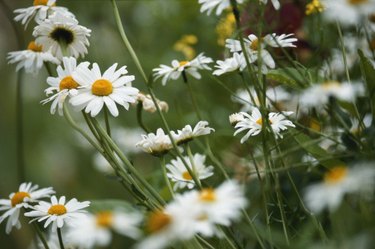
Perennial gardeners who plant low-maintenance plants know that Shasta daisies belong in borders of daylilies, coneflowers and August lilies. Given a brunch of well-rotted compost each spring, they produce sunny white flowers from late May or early June through the summer and into fall. Of course, like any lady, this daisy appreciates a little attention when she wilts.
Weak Stems
Video of the Day
If Shasta daisies wilt, try deadheading flowers as they start to set seed. It is possible that flower heads are just too heavy. Shasta daisy cultivars range from 6 inches to 4 feet tall and newer hybrid stems are stronger. Older cultivars such as "Alaska" tend to droop after their first bloom. Deadheading stems down to the first set of leaves not only removes fading leaves and concentrates nutrients on new flowers and can extend the period of bloom. Another way to encourage stronger stem growth is to divide clumps every two or three years, promoting aggressive root growth that supports sturdy top growth.
Video of the Day
Too Little
Shasta daisies grow in thick clumps from strong tubers. They take several years to develop when planted from seed. Until tubers become established, plants are too thinly distributed to support others. Newer, more compact varieties, such as Snow Lady, Snow Cap and Becky, grow denser at a younger age than older varieties. Although plants may flop over, flower stems will stand upright as flowers point toward the sun. Too little sun and lack of mulch also lead to plants that wilt after blooming. Shasta daisies need full sun between six and eight hours during the day, but partial shade during the hottest part of the day is beneficial in southern growing zones. Several inches of mulch keeps their shallow roots cool.
Too Much
When Luther Burbank introduced the Shasta daisy (Leucanthemum x superbum or Leucanthemum x maximum) in the early 20th century, choices in fertilizer were limited for home gardeners. Too much high nitrogen fertilizer may lead to droopy plants; a thin layer of well-rotted compost will keep them healthy and perky. Too much water also promotes wilting. Plants need about an inch of water a week. They begin growing upward again when heavy rains end.
Fungal Wilts
Wilting Shasta daisies most often results from heavy flower heads or plant culture, but two soil borne fungal infections occasionally strike the daisy patch. Acremonium wilt (Acremonium strictum) causes wilting accompanied by browning of plant tissue and death of lower leaves. Cottony rot (Sclerotinia sclerotiorum) also causes wilting. Large black spots form on stems and the base of the stem rots. The fungus often inhabits soil in the vicinity of gardens containing carrots, celery and lettuce. Cottony masses, which give the fungus its common name, may form on stems in damp weather. Removal of affected plants and application of fungicides treat the conditions.
- University of Illinois Extension; Shasta Daisies: A Beautiful Addition; David J. Robson; 2007
- Washington State University Extension: Shasta Daisy
- National Gardening Association: Shasta Daisy
- University of California Integrated Pest Management; Shasta Daisy; 2009
- Missouri Botanical Garden: Alphabetical List of Plants in PlantFinder L